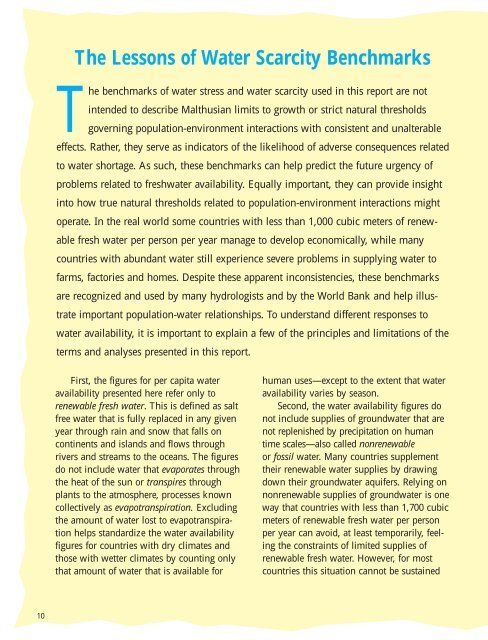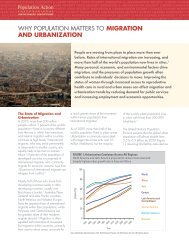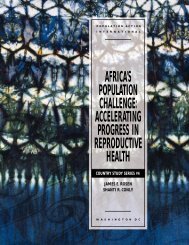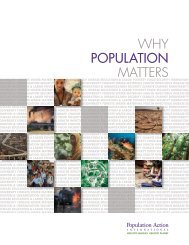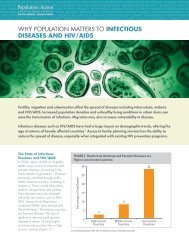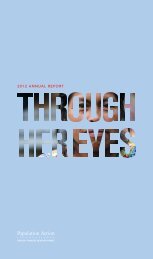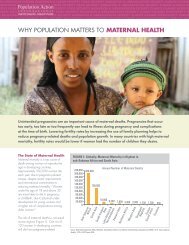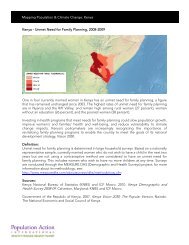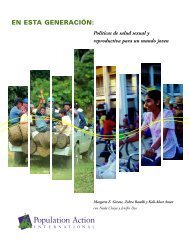Sustaining water, easing scarcity - Population Action International
Sustaining water, easing scarcity - Population Action International
Sustaining water, easing scarcity - Population Action International
You also want an ePaper? Increase the reach of your titles
YUMPU automatically turns print PDFs into web optimized ePapers that Google loves.
The Lessons of Water Scarcity Benchmarks<br />
The benchmarks of <strong>water</strong> stress and <strong>water</strong> <strong>scarcity</strong> used in this report are not<br />
intended to describe Malthusian limits to growth or strict natural thresholds<br />
governing population-environment interactions with consistent and unalterable<br />
effects. Rather, they serve as indicators of the likelihood of adverse consequences related<br />
to <strong>water</strong> shortage. As such, these benchmarks can help predict the future urgency of<br />
problems related to fresh<strong>water</strong> availability. Equally important, they can provide insight<br />
into how true natural thresholds related to population-environment interactions might<br />
operate. In the real world some countries with less than 1,000 cubic meters of renewable<br />
fresh <strong>water</strong> per person per year manage to develop economically, while many<br />
countries with abundant <strong>water</strong> still experience severe problems in supplying <strong>water</strong> to<br />
farms, factories and homes. Despite these apparent inconsistencies, these benchmarks<br />
are recognized and used by many hydrologists and by the World Bank and help illustrate<br />
important population-<strong>water</strong> relationships. To understand different responses to<br />
<strong>water</strong> availability, it is important to explain a few of the principles and limitations of the<br />
terms and analyses presented in this report.<br />
First, the figures for per capita <strong>water</strong><br />
availability presented here refer only to<br />
renewable fresh <strong>water</strong>. This is defined as salt<br />
free <strong>water</strong> that is fully replaced in any given<br />
year through rain and snow that falls on<br />
continents and islands and flows through<br />
rivers and streams to the oceans. The figures<br />
do not include <strong>water</strong> that evaporates through<br />
the heat of the sun or transpires through<br />
plants to the atmosphere, processes known<br />
collectively as evapotranspiration. Excluding<br />
the amount of <strong>water</strong> lost to evapotranspiration<br />
helps standardize the <strong>water</strong> availability<br />
figures for countries with dry climates and<br />
those with wetter climates by counting only<br />
that amount of <strong>water</strong> that is available for<br />
human uses—except to the extent that <strong>water</strong><br />
availability varies by season.<br />
Second, the <strong>water</strong> availability figures do<br />
not include supplies of ground<strong>water</strong> that are<br />
not replenished by precipitation on human<br />
time scales—also called nonrenewable<br />
or fossil <strong>water</strong>. Many countries supplement<br />
their renewable <strong>water</strong> supplies by drawing<br />
down their ground<strong>water</strong> aquifers. Relying on<br />
nonrenewable supplies of ground<strong>water</strong> is one<br />
way that countries with less than 1,700 cubic<br />
meters of renewable fresh <strong>water</strong> per person<br />
per year can avoid, at least temporarily, feeling<br />
the constraints of limited supplies of<br />
renewable fresh <strong>water</strong>. However, for most<br />
countries this situation cannot be sustained<br />
10


